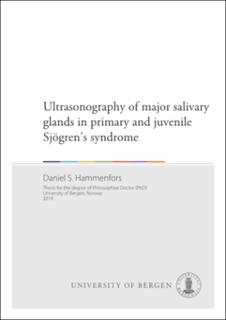| dc.contributor.author | Hammenfors, Daniel S. | en_US |
| dc.date.accessioned | 2019-07-02T10:47:42Z | |
| dc.date.available | 2019-07-02T10:47:42Z | |
| dc.date.issued | 2019-06-07 | |
| dc.identifier | container/90/d4/59/b3/90d459b3-94aa-4f6c-b9d5-ce9a03409cae | |
| dc.identifier.isbn | 9788230863374 | en_US |
| dc.identifier.isbn | 9788230867327 | en_US |
| dc.identifier.uri | https://hdl.handle.net/1956/20540 | |
| dc.description.abstract | Background: Primary Sjögrens’s syndrome (pSS) is a systemic autoimmune disease, mainly affecting the salivary and lacrimal glands. Primary SS can also affect the younger population and when it does, the denomination is Juvenile SS (jSS). The salivary gland component in SS is commonly evaluated by histopathological detection of focal mononuclear cell inflammation in a minor labial salivary gland. Other methods are needed when a lip biopsy is inconclusive or cannot be performed. Interest in noninvasive major salivary gland ultrasonography (SGUS) is increasing for both clinical practice and research. Aim: To investigate the use of SGUS in the diagnostic evaluation of pSS and jSS. Methods: In Paper I, we included 97 well-characterized pSS patients. Paper II included patients diagnosed with jSS at the age of 18 years or younger, and younger than 25 years at inclusion. The cohort in Paper III consisted of 32 consecutive SS patients. In Paper I-III, we collected clinical data and performed a clinical examination including Schirmer’s I-test and sialometry. In Paper I and Paper III, we also included new serology/laboratory tests. For all three papers, SGUS of the parotid and submandibular glands was performed and evaluated using a simplified scoring system (0-3). In Paper I, the SGUS examinations were digitally stored as images and evaluated and scored at a later time-point. In Paper II, the SGUS examinations were evaluated and scored bedside. In Paper III, the SGUS examinations were evaluated and scored both bedside and post-examination. Post-examination evaluation and scoring was performed on both images and videos, at two different time-points. Results: In Paper I, the female:male ratio was 91:6 (15.2:1), and the mean age 61.3 years. All patients fulfilled the AECG classification criteria for pSS. We found pathological SGUS findings (SGUS+) in 51/97 patients (52.6% sensitivity). SGUS+ was associated with hyposalivation, reduced tear secretion, and elevated titers of anti- Ro/SSA and anti-La/SSB. In Paper II, the female:male ratio was 58:9 (6.4:1). Mean age at first symptom was 10.2 years and mean age at diagnosis was 12.1 years. Ocular and oral symptoms were noted in 42/67 and 53/66 patients, respectively. The AECG or ACR/EULAR classification criteria for pSS were fulfilled by 42/67 patients. SGUS+ was observed in 41/67 patients (61.2% sensitivity). The AECG and/or ACR/EULAR criteria was fulfilled by 26/41 SGUS+ patients. SGUS+ was associated with hyposalivation and elevated titres of anti-Ro/SSA, anti-La/SSB and rheumatoid factor. Salivary gland enlargements/parotitis was noted in 37/58 patients and non-significantly associated with SGUS+. In Paper III, the female:male ratio was 7:1, and the mean age 56 years. The ACR/EULAR classification criteria for pSS was fulfilled by 24/42 patients. SGUS+ was observed in 14/32 patients (43.8% sensitivity). Results from the first round of video and image evaluations were used to calculate interobserver agreement and was compared to the bedside evaluations. The second round of evaluations were compared to the first round to calculate intraobserver agreements. The inter- and intraobserver agreement was overall good to excellent. Image and video evaluation compared to bedside evaluation revealed a slightly better agreement for longitudinal video of the parotid gland. Conclusion: Pathological SGUS findings correlate with several clinical and laboratory findings for both pSS and jSS, adding important information to the diagnostic evaluation. Using a simplified scoring system, both inter- and intrarater correlations were excellent for experienced examiners, with longitudinal video of the parotid gland proving most reliable for post-examination evaluation. | en_US |
| dc.language.iso | eng | eng |
| dc.publisher | The University of Bergen | eng |
| dc.relation.haspart | Paper I: Daniel S. Hammenfors, Johan G. Brun, Roland Jonsson, Malin V. Jonsson. Diagnostic utility of major salivary gland ultrasonography in primary Sjögren's syndrome. Clinical and Experimental Rheumatology 2015; 33(1):56-62. The article is not available in BORA due to publisher restrictions. The published version is available at: <a href="https://www.clinexprheumatol.org/abstract.asp?a=8199" target="blank">https://www.clinexprheumatol.org/abstract.asp?a=8199</a> | en_US |
| dc.relation.haspart | Paper II: Daniel S. Hammenfors, Valéria Valim, Blanca E. R. G. Bica, Sandra G. Pasoto, Vibke Lilleby, Juan Carlos Nieto-González, Clovis A. Silva, Esther Mossel, Rosa M. R. Pereira, Aline Coelho, Hendrika Bootsma, Akaluck Thatayatikom, Johan G. Brun, Malin V. Jonsson. Juvenile Sjögren’s syndrome: clinical characteristics with focus on salivary gland ultrasonography. Arthritis Care and Research 2020; 72(1):78-87. The article is available in the main thesis. The article is also available at: <a href="https://doi.org/10.1002/acr.23839" target="blank"> https://doi.org/10.1002/acr.23839</a> | en_US |
| dc.relation.haspart | Paper III: Daniel S. Hammenfors, Haris Causevic, Jörg Assmus, Johan G. Brun, Roland Jonsson, Malin V. Jonsson. Assessment of major salivary gland ultrasonography in Sjögren’s syndrome - A comparison between bedside and post-examination evaluations. The article is not available in BORA. | en_US |
| dc.rights | In copyright | |
| dc.rights.uri | http://rightsstatements.org/page/InC/1.0/ | |
| dc.title | Ultrasonography of major salivary glands in primary and juvenile Sjögren’s syndrome | en_US |
| dc.type | Doctoral thesis | |
| dc.rights.holder | Copyright the author. All rights reserved | |
| dc.identifier.cristin | 1707836 | |
